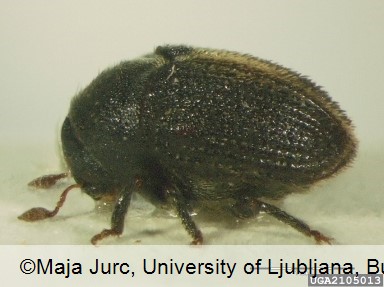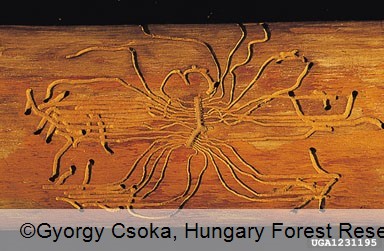Animalia
Lesser Ash bark beetle
Hylesinus oleiperda
Maarten de Groot
|
|

Fig. 1. Adult of Hylesinus oleiperda

Fig. 2. Galleries of Hylesinus oleiperda
DETECTION PERIOD:
March-May (flight period), whole year (damage)
DESCRIPTION:
Adults are small black bark beetles (2.5-3 mm). Body is covered with sparse yellow hairs. Antenna are club shaped and red. The larvae are white. The adults are making a short, not distinctly two-armed transversed egg tunnel. The larvae tunnels are long and irregular. a characteristic V-shaped gallery system in the cambium from which the larvae are meandering perpendicular of the maternal tunnels into the wood. The adults are hibernating in overwintering galleries in and below the axils of small branches and twigs, but rarely produces galls on the bark.
HABITAT:
It has the galleries in thin stems and branches. It mainly attacks already weakened trees. The main host of this species are ash species (Fraxinus spp.), Olea europaea, Syringa vulgaris and Ligustrum vulgare.
STATUS:
Occurs in almost all countries in the REFOCuS area (Austria, Croatia, Hungary and Slovenia). In Serbia there is no data available.
IMPACT:
Larvae of the ash bark beetle are feeding on cambium of the thin stems and branches. It attacks weakened trees. For Ash trees it is not considered an economical pest, however for olive it is regarded as an economical pest.
SIMILAR SPECIES:
Can be confused with other bark beetles on ashes like H. crenatus and H. oleiperda. The adult is small and black and should be determined in the laboratory. gallery system is shorter compared to H. crenatus and H. fraxini, and it mainly has the branches.
|